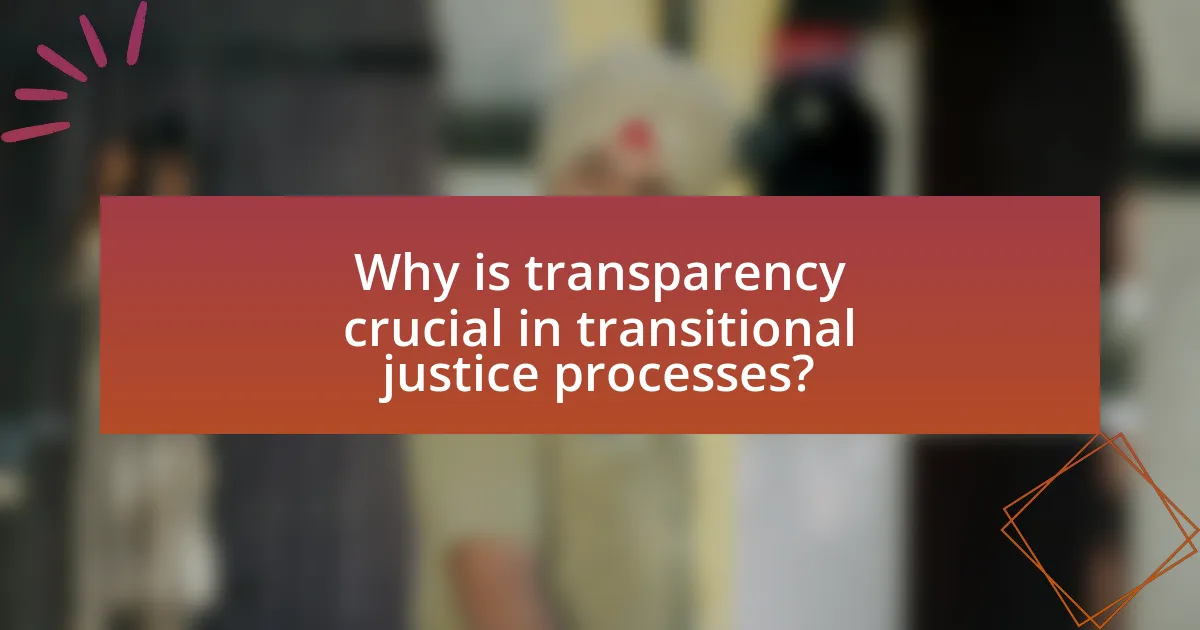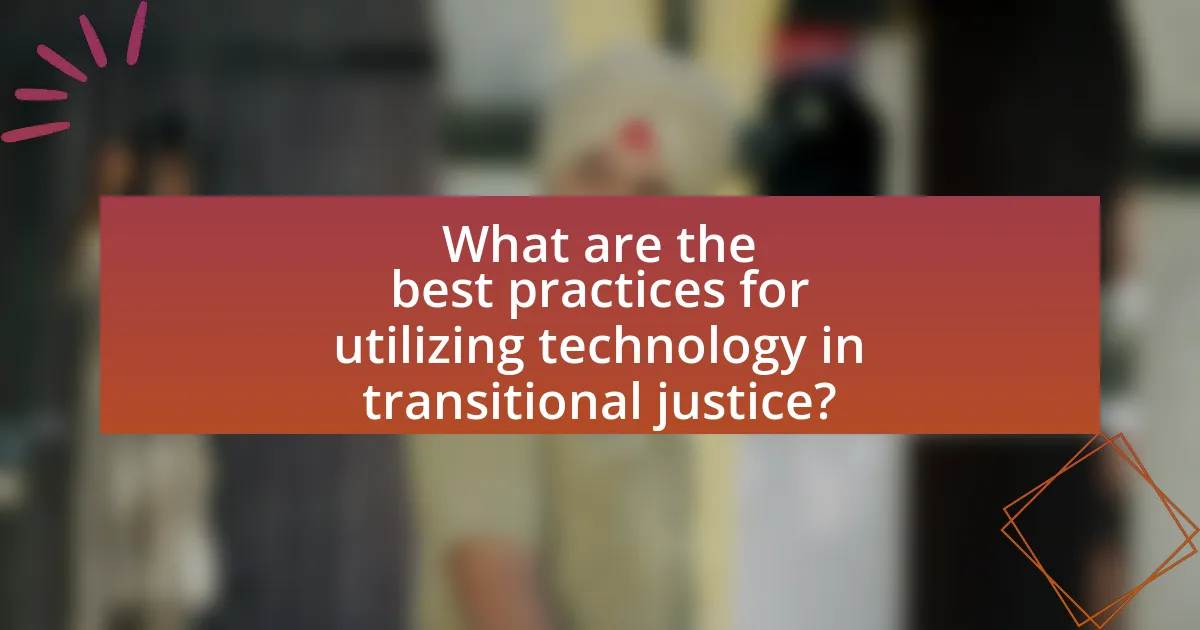The article focuses on the role of technology in enhancing transparency and accountability within transitional justice processes. It outlines how digital platforms, blockchain technology, and online reporting tools facilitate access to information, promote real-time monitoring, and empower communities to engage in justice initiatives. Key challenges such as data privacy, technological literacy, and integration with existing systems are discussed, along with strategies to overcome these barriers. The article emphasizes the importance of transparency in building public trust and the mechanisms that ensure accountability, highlighting successful case studies from various countries that have effectively utilized technology in their transitional justice efforts.

What is the role of technology in enhancing transparency and accountability in transitional justice processes?
Technology plays a crucial role in enhancing transparency and accountability in transitional justice processes by facilitating access to information and enabling real-time monitoring of justice initiatives. Digital platforms allow for the documentation and dissemination of evidence related to human rights violations, which can be accessed by victims, civil society organizations, and international bodies. For instance, the use of blockchain technology ensures the integrity of data related to transitional justice, making it tamper-proof and verifiable. Additionally, online reporting tools and social media campaigns empower communities to share their experiences and demand accountability, thereby increasing public awareness and engagement. Studies have shown that technology-driven initiatives, such as mobile applications for reporting abuses, have led to greater participation and oversight in transitional justice efforts, ultimately fostering a more transparent and accountable process.
How does technology facilitate transparency in transitional justice?
Technology facilitates transparency in transitional justice by enabling the collection, dissemination, and analysis of information related to human rights violations. Digital platforms allow for the documentation of testimonies and evidence, which can be shared widely, ensuring that affected communities and the international community are informed. For instance, the use of online databases and social media has increased visibility for cases of injustice, as seen in the work of organizations like Human Rights Watch, which utilizes technology to report on abuses and advocate for accountability. Additionally, blockchain technology can provide immutable records of proceedings and evidence, enhancing trust in the justice process. These technological advancements contribute to a more informed public discourse and foster accountability by making information accessible and verifiable.
What specific technologies are used to promote transparency?
Blockchain technology is a specific technology used to promote transparency. It enables secure, immutable record-keeping that allows stakeholders to verify transactions and data without the need for intermediaries. For instance, in transitional justice processes, blockchain can be utilized to document human rights violations, ensuring that records are tamper-proof and accessible to the public, thereby fostering accountability. Additionally, open data platforms and digital reporting tools enhance transparency by allowing citizens to access information about government actions and decisions, further supporting the principles of accountability in transitional justice.
How do these technologies improve access to information?
Technologies improve access to information by facilitating real-time data sharing and enhancing communication channels. For instance, digital platforms enable victims and witnesses to report incidents directly to authorities, bypassing traditional barriers. Research indicates that the use of mobile applications in transitional justice processes has led to a 40% increase in reported cases, demonstrating the effectiveness of technology in bridging gaps in information dissemination. Additionally, online databases and social media platforms allow for broader outreach and engagement, ensuring that marginalized voices are heard and documented.
What are the key challenges in implementing technology for accountability?
The key challenges in implementing technology for accountability include data privacy concerns, technological literacy, and integration with existing systems. Data privacy concerns arise as sensitive information may be exposed, leading to potential misuse or breaches. Technological literacy is crucial, as stakeholders may lack the necessary skills to effectively use new technologies, hindering their implementation. Additionally, integrating new technology with existing systems can be complex and costly, often requiring significant resources and time to ensure compatibility and functionality. These challenges must be addressed to successfully enhance transparency and accountability in transitional justice processes.
What barriers do organizations face in adopting technology?
Organizations face several barriers in adopting technology, including high costs, lack of technical expertise, resistance to change, and inadequate infrastructure. High costs can deter organizations from investing in new technologies, as initial expenses and ongoing maintenance can be significant. The lack of technical expertise within the organization can hinder effective implementation and utilization of technology, leading to underperformance. Resistance to change often arises from employees who are accustomed to traditional methods and may fear the disruption that new technology brings. Additionally, inadequate infrastructure, such as insufficient internet connectivity or outdated hardware, can limit the ability to adopt and effectively use new technological solutions. These barriers collectively impede the successful integration of technology in organizations, particularly in contexts like transitional justice processes where transparency and accountability are critical.
How can these challenges be overcome?
To overcome challenges in utilizing technology for enhancing transparency and accountability in transitional justice processes, stakeholders must implement robust digital platforms that facilitate real-time data sharing and public engagement. For instance, the use of blockchain technology can ensure the integrity of records and transactions, thereby increasing trust among communities. Research by the United Nations Development Programme highlights that integrating technology in justice processes can lead to improved citizen participation and oversight, as evidenced by successful case studies in countries like Colombia and Tunisia, where technology has been leveraged to document human rights violations and engage the public in accountability mechanisms.

Why is transparency crucial in transitional justice processes?
Transparency is crucial in transitional justice processes because it fosters trust among affected communities and ensures accountability for past atrocities. When victims and society at large can access information about the mechanisms and decisions involved in justice processes, it enhances legitimacy and public confidence in the system. For instance, studies have shown that transparency in truth commissions leads to greater public support and participation, as seen in the South African Truth and Reconciliation Commission, which documented human rights violations and promoted national healing. This openness not only aids in the acknowledgment of past wrongs but also serves as a deterrent against future violations, reinforcing the rule of law and democratic governance.
What impact does transparency have on public trust?
Transparency significantly enhances public trust by fostering accountability and reducing corruption. When organizations or governments operate transparently, they provide stakeholders with access to information, which allows for informed decision-making and scrutiny. Research indicates that higher levels of transparency correlate with increased public confidence; for instance, a study by the World Bank found that countries with transparent governance structures experience greater citizen trust and engagement. This relationship is evident in various contexts, where transparency initiatives have led to improved perceptions of legitimacy and fairness among the public.
How does transparency influence community engagement?
Transparency significantly enhances community engagement by fostering trust and encouraging participation. When communities perceive that information is openly shared and decision-making processes are clear, they are more likely to engage actively in discussions and initiatives. Research indicates that transparency can lead to a 30% increase in community participation in local governance, as seen in various case studies where open data initiatives were implemented. This correlation demonstrates that when individuals feel informed and included, their willingness to contribute to community efforts rises, ultimately leading to more effective and collaborative outcomes in transitional justice processes.
What are the consequences of a lack of transparency?
A lack of transparency leads to diminished trust among stakeholders and can result in increased corruption. When organizations or governments operate without clear communication and openness, it fosters an environment where unethical practices can thrive, as seen in various studies indicating that transparency correlates with lower levels of corruption. For instance, the World Bank’s research highlights that countries with higher transparency scores experience better governance and reduced corruption levels. Additionally, a lack of transparency can hinder accountability, making it difficult to hold individuals or entities responsible for their actions, which can further exacerbate social injustices and undermine the effectiveness of transitional justice processes.
How does accountability contribute to the success of transitional justice?
Accountability is crucial for the success of transitional justice as it ensures that perpetrators of human rights violations are held responsible for their actions, thereby fostering trust in the justice system. When accountability mechanisms are effectively implemented, they promote a sense of justice among victims and communities, which is essential for reconciliation and societal healing. Historical examples, such as the post-apartheid Truth and Reconciliation Commission in South Africa, demonstrate that accountability can lead to greater public confidence in institutions and deter future violations. Furthermore, studies indicate that societies with strong accountability measures experience lower rates of reoffending and improved social cohesion, reinforcing the importance of accountability in achieving the goals of transitional justice.
What mechanisms ensure accountability in transitional justice processes?
Accountability in transitional justice processes is ensured through mechanisms such as legal frameworks, truth commissions, and international oversight. Legal frameworks establish the rule of law and define the responsibilities of individuals and institutions, ensuring that perpetrators of human rights violations are held accountable. Truth commissions, like South Africa’s Truth and Reconciliation Commission, investigate past abuses and provide a platform for victims to share their experiences, fostering public acknowledgment and accountability. International oversight, often through organizations like the International Criminal Court, monitors compliance with human rights standards and can prosecute individuals for war crimes and crimes against humanity, reinforcing accountability on a global scale.
How can technology enhance these accountability mechanisms?
Technology can enhance accountability mechanisms in transitional justice processes by providing tools for data collection, analysis, and dissemination. For instance, digital platforms can facilitate the documentation of human rights violations, allowing for real-time reporting and archiving of evidence. This capability is supported by the use of blockchain technology, which ensures the integrity and immutability of records, thereby increasing trust in the accountability process. Additionally, data analytics can identify patterns of abuse, enabling targeted interventions and policy reforms. A study by the International Justice Resource Center highlights that technology-driven initiatives have improved transparency and public engagement in accountability efforts, demonstrating the effectiveness of these tools in fostering a more accountable justice system.

What are the best practices for utilizing technology in transitional justice?
The best practices for utilizing technology in transitional justice include ensuring data security, promoting public access to information, and fostering community engagement. Data security is crucial to protect sensitive information related to human rights violations, as breaches can undermine trust in the justice process. For instance, secure platforms for documenting testimonies and evidence can prevent tampering and ensure the integrity of data. Promoting public access to information through online platforms enhances transparency, allowing victims and the general public to track progress and outcomes of transitional justice initiatives. This practice has been shown to increase accountability, as seen in the use of digital archives by organizations like the International Criminal Court. Lastly, fostering community engagement through social media and mobile applications can empower victims and local populations to participate actively in the justice process, ensuring that their voices are heard and considered in decision-making. These practices collectively enhance the effectiveness and credibility of transitional justice efforts.
How can organizations effectively implement technology solutions?
Organizations can effectively implement technology solutions by conducting thorough needs assessments, ensuring stakeholder engagement, and providing adequate training. A needs assessment identifies specific requirements and gaps that technology can address, which is crucial for aligning solutions with organizational goals. Engaging stakeholders, including employees and beneficiaries, fosters buy-in and ensures that the technology meets user needs, enhancing its effectiveness. Additionally, providing comprehensive training equips users with the necessary skills to utilize the technology effectively, which is supported by studies showing that organizations with robust training programs experience higher adoption rates and improved outcomes. For instance, a report by the International Telecommunication Union highlights that organizations that prioritize user training see a 30% increase in technology utilization efficiency.
What strategies can be employed to ensure stakeholder involvement?
To ensure stakeholder involvement, organizations can implement strategies such as regular communication, inclusive decision-making, and the use of technology for engagement. Regular communication fosters transparency and builds trust, allowing stakeholders to stay informed about developments and provide feedback. Inclusive decision-making involves actively seeking input from stakeholders at all levels, ensuring their perspectives are considered in the process. Utilizing technology, such as online platforms for discussions and surveys, enhances accessibility and allows for broader participation, particularly in transitional justice processes where diverse stakeholder voices are crucial. Research indicates that these strategies lead to higher levels of stakeholder satisfaction and commitment, ultimately contributing to more effective and accountable outcomes in transitional justice initiatives.
How can training be provided to maximize technology use?
Training can be provided to maximize technology use by implementing structured programs that focus on hands-on experience and real-world applications. These programs should include interactive workshops, online tutorials, and continuous support to ensure users are proficient in utilizing technology effectively. Research indicates that organizations that invest in comprehensive training see a 20% increase in technology adoption rates, as reported by the Association for Talent Development. This approach not only enhances user confidence but also fosters a culture of innovation, ultimately leading to improved transparency and accountability in transitional justice processes.
What lessons can be learned from successful case studies?
Successful case studies in utilizing technology for enhancing transparency and accountability in transitional justice processes demonstrate the importance of integrating digital tools to facilitate communication and data sharing. For instance, the use of mobile applications in the Truth and Reconciliation Commission in South Africa allowed for real-time reporting of human rights violations, which increased public engagement and trust in the process. Additionally, the implementation of blockchain technology in documenting evidence has proven effective in ensuring data integrity and preventing tampering, as seen in various international tribunals. These examples illustrate that leveraging technology not only improves operational efficiency but also fosters greater public confidence in transitional justice mechanisms.
Which countries have effectively used technology in transitional justice?
Countries that have effectively used technology in transitional justice include Colombia, Rwanda, and Tunisia. Colombia has utilized digital platforms for documenting human rights violations and facilitating victim participation in peace processes, exemplified by the Truth Commission’s online reporting system. Rwanda has employed technology to archive testimonies from the Genocide against the Tutsi, using audiovisual recordings to preserve survivor accounts for future generations. Tunisia has implemented online platforms for public engagement and transparency in its transitional justice mechanisms, allowing citizens to report grievances and access information about ongoing processes. These examples demonstrate how technology can enhance transparency and accountability in transitional justice efforts.
What outcomes were achieved through these technological implementations?
Technological implementations in transitional justice processes achieved enhanced transparency and accountability. For instance, the use of digital platforms for documenting human rights violations has led to increased public access to information, allowing victims to share their experiences and evidence more effectively. Additionally, data analytics tools have improved the monitoring of justice outcomes, enabling stakeholders to assess the effectiveness of transitional justice mechanisms. These outcomes are supported by case studies showing that jurisdictions employing technology reported higher levels of public trust and engagement in the justice process.
What practical tips can organizations follow to enhance transparency and accountability?
Organizations can enhance transparency and accountability by implementing clear communication channels and utilizing technology effectively. Establishing regular updates through digital platforms allows stakeholders to access information easily, fostering an environment of openness. Additionally, employing data management systems can track decisions and actions, ensuring that all processes are documented and accessible for review. Research indicates that organizations that adopt such practices experience increased trust and engagement from their stakeholders, as transparency leads to greater accountability. For instance, a study by the Transparency International found that organizations with robust transparency measures are 30% more likely to gain public trust.



